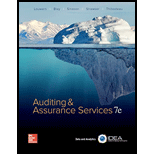
Determine the sample rate of deviation, ULRD, and allowance for sampling risk for each condition.
Explanation of Solution
Attributes sampling: Attributes sampling helps the auditor to assess a specific rate of occurrence for a specific characteristic of the audit population. It is helpful in finding the estimate related to a particular transaction or activity in the system.
Sample rate of deviation: It is a rate of deviation that ascertains the percentage of occurrence and accuracy of control. Sample rate of deviation is calculated by using the following formula:
Upper Limit Rate of Deviation (ULRD): It is an adjusted deviation rate that ascertains a conservative measure of the population rate of deviation and allows the auditor to control the disclosure of sampling risk to acceptable levels.
Allowance for sampling risk: It is the “adjustment” of the sample deviation rate for the acceptable risk of overreliance. Allowance for sampling risk is calculated by using the following formula:
a.
Determine the sample rate of deviation.
Determine ULRD by using AICPA sample evaluation tables.
According to the AICPA sample evaluation tables, the ULRD for 8 deviations of 100
Determine allowance for sampling risk.
Hence, the sample rate of deviation, upper limit rate of deviation and allowance for sampling risk is 8%, 14% and 6% respectively.
b.
Determine the sample rate of deviation.
Determine ULRD by using AICPA sample evaluation tables.
According to the AICPA sample evaluation tables, the ULRD for 4 deviations of 100 sample size at 5% risk of overreliance is 9%.
Determine allowance for sampling risk.
Hence, the sample rate of deviation, upper limit rate of deviation and allowance for sampling risk is 4%, 9% and 5% respectively.
c.
Determine the sample rate of deviation.
Determine ULRD by using AICPA sample evaluation tables.
According to the AICPA sample evaluation tables, the ULRD for 8 deviations of 100 sample size at 10% risk of overreliance is 12.7%.
Determine allowance for sampling risk.
Hence, the sample rate of deviation, upper limit rate of deviation and allowance for sampling risk is 8%, 12.7% and 4.7% respectively.
Write the comments for the relationship of each factor to the ULRD.
Explanation of Solution
The difference of ULRD in (a) and (b) is due to decrease in number of deviation from 8 (in a) to 4 (in b). Here, the decrease in ULRD from 14% to 9% indicates that the number of deviations and sample rate of deviation is directly proportional to ULRD.
The difference of ULRD in (a) and (c) is due to increase in the risk of overreliance from 5% (in a) to 10% (in c). Here, the decrease in ULRD from 14% to 12.7% indicates that the risk of overreliance is inversely proportional to ULRD.
Want to see more full solutions like this?
Chapter F Solutions
Auditing & Assurance Services (Auditing and Assurance Services)
- Evergreen Systems purchased machinery for $92,000 on January 1, 2020. Additional costs included $4,500 in delivery charges and $8,000 for installation and setup. The machinery is expected to have a salvage value of $20,000 at the end of its 4-year useful life. What is the amount of accumulated depreciation on December 31, 2021, using the straight-line method? Helparrow_forwardWhat is the company's contribution margin ratio ?arrow_forwardYour firm purchases a business copier that costs $14,000 and requires $3,000 in maintenance for each year of its four-year life. After four years, the copier will be replaced. The copier falls into the MACRS three-year class life category. Use DDB depreciation. If the tax rate is 32 percent, what is the depreciation tax shield for this project in year 4?arrow_forward
- What would be his recognize gain ?arrow_forwardLynn Inc has provided the following data from its activity-based systemarrow_forwardThe GNR Manufacturing Co. recorded overhead costs of $21,500 at an activity level of 5,000 machine hours and $8,000 at 2,500 machine hours. The records also indicated that overhead of $10,000 was incurred at 4,200 machine hours. Using the high-low method to estimate the cost equation, determine the variable cost per machine hour.arrow_forward

 AccountingAccountingISBN:9781337272094Author:WARREN, Carl S., Reeve, James M., Duchac, Jonathan E.Publisher:Cengage Learning,
AccountingAccountingISBN:9781337272094Author:WARREN, Carl S., Reeve, James M., Duchac, Jonathan E.Publisher:Cengage Learning, Accounting Information SystemsAccountingISBN:9781337619202Author:Hall, James A.Publisher:Cengage Learning,
Accounting Information SystemsAccountingISBN:9781337619202Author:Hall, James A.Publisher:Cengage Learning, Horngren's Cost Accounting: A Managerial Emphasis...AccountingISBN:9780134475585Author:Srikant M. Datar, Madhav V. RajanPublisher:PEARSON
Horngren's Cost Accounting: A Managerial Emphasis...AccountingISBN:9780134475585Author:Srikant M. Datar, Madhav V. RajanPublisher:PEARSON Intermediate AccountingAccountingISBN:9781259722660Author:J. David Spiceland, Mark W. Nelson, Wayne M ThomasPublisher:McGraw-Hill Education
Intermediate AccountingAccountingISBN:9781259722660Author:J. David Spiceland, Mark W. Nelson, Wayne M ThomasPublisher:McGraw-Hill Education Financial and Managerial AccountingAccountingISBN:9781259726705Author:John J Wild, Ken W. Shaw, Barbara Chiappetta Fundamental Accounting PrinciplesPublisher:McGraw-Hill Education
Financial and Managerial AccountingAccountingISBN:9781259726705Author:John J Wild, Ken W. Shaw, Barbara Chiappetta Fundamental Accounting PrinciplesPublisher:McGraw-Hill Education





